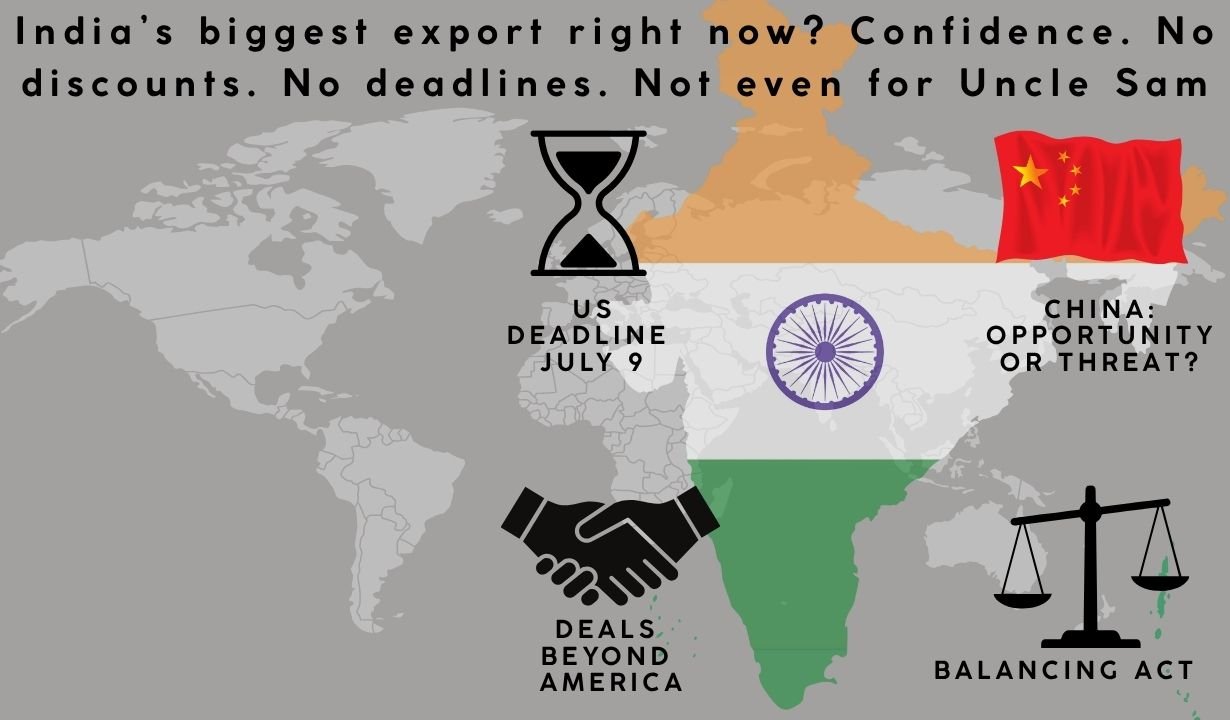India’s Foreign Trade Tightrope — Deals, Deadlines & the China Conundrum
India’s foreign trade game is heating up — and it’s no longer about padding export numbers. With a looming July 9 deadline for U.S. tariffs, and complex negotiations underway with Saudi Arabia, UAE, Israel, Oman, Qatar, EU, Brazil, Russia, Argentina — it’s all hands on deck.
India foreign trade policy is now under unprecedented scrutiny as the nation tries to balance economic opportunity with geopolitical caution.
The U.S. Deadline: July 9
Here’s the curveball: The U.S. has threatened to reinstate steep reciprocal tariffs (10–50%, possibly rising to 70%) by August 1, but letters go out on July 9— that’s today. U.S. officials say nations working in “good faith” may get extensions, but uncertainty is massive.
India could face a brutal 26% tariff on exports if no interim deal is struck. It’s not just a trade threat — it’s a business-breaking blow. But Commerce Minister Piyush Goyal drew red lines: no rushed deal, no turf surrendered. The ball, as they say, is squarely in the U.S. court.
The stakes are particularly high in the context of the India U.S. trade deal 2025, which could redefine bilateral commerce for the next decade.
Global Chatter: Deals Beyond America
Parallel to the U.S. showdown, India is quietly negotiating Free Trade Agreements and strategic partnerships with Middle East nations (Saudi, UAE, Oman, Qatar, Israel via I2U2/ IMEC corridors), Europe (EU), Brazil, Russia, Argentina, and others. The ambition: reposition India beyond traditional trading blocs, tapping into energy, tech, infrastructure, and digital commerce corridors.
These India free trade agreements could serve as a hedge against Western economic turbulence and offer India a wider global footprint.
China: Opportunity or Threat?
Here’s the rub: China is both India’s largest trading partner and its biggest geopolitical rival. Any major push into Middle East/EU/Brazil—especially through corridors like I2U2—draws Beijing’s glare. And Beijing’s aggressive push to frame BRICS + tariff alignment could backfire on Indian exporters.
In the backdrop of India-China trade relations, the path ahead is anything but linear.
But there’s opportunity too. Waning Chinese influence in the West creates an opening for Indian goods and services—especially if Doha, Riyadh, or Berlin are buying.
Pros & Cons: India-U.S. Trade Deal
Plus Points
- Immediate tariff relief (no 26%)
- Opens U.S. market for agri & dairy slowly
- Up to $500 billion bilateral trade by 2030 roadmap
- Boost to exports (auto, pharma, textiles, gems)
Downsides
- Pressure to open agri/dairy sectors — politically sensitive
- Risk of undercutting MSMEs not ready to compete
- Concessions on data, digital services, or IP could surface
The Balancing Act
India is playing smart:
- No rush to accept tariff punishment
- Threshold-ready for mini-deals that don’t compromise national interest
- Simultaneously negotiating with EU, Middle East, and BRICS+-aligned nations to diversify risk
Behind the scenes, India trade negotiations are running on full throttle — balancing diplomacy, economics, and national interest.
Final Takeaway
The next few days are India’s foreign trade inflection point.
A moderate U.S. deal could cushion the blow—but not at any cost.
The wider narrative—FTAs, corridors, diversification—matters more for long-term resilience, especially as China plays both ally and antagonist.
India foreign trade policy, in its current avatar, is no longer reactive — it’s assertive, layered, and future-facing.
Because in 2025’s global trade battlefield, survival isn’t enough.
India needs either to shape the battlefield or walk out unscathed.
As the July 9 deadline ticks down, India’s foreign trade policy is being tested like never before — in real-time, on a global stage.






THE GREAT NORTH INDIA SMOG CHRONICLES: NOW WITH VOLCANIC DLC FROM ETHIOPIA